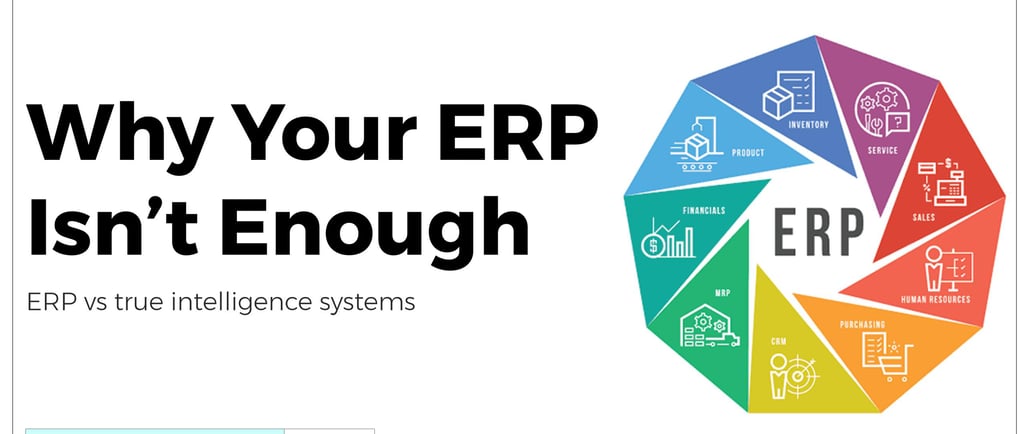Why Your ERP Isn't Enough
Your ERP can’t deliver foresight. Learn why intelligent systems are the next step for data-driven enterprise growth.
ENTERPRISE INTELLIGENCE
Oluwatayo Winkunle
8/1/20253 min read


Why Your ERP Isn’t Enough: What True Intelligence Systems Look Like
Many businesses proudly tout their ERP systems as the core of their digital transformation. And for a time, that’s been enough.
But in today’s AI-powered economy, an ERP alone won’t take you far.
If you’re still relying solely on ERP dashboards to make strategic decisions, you’re likely falling behind. Why? Because ERPs are not built to give you foresight. They’re built to help you manage operations, not drive transformation.
Let’s break this down.
ERPs Are Strong at Tracking. But Not Thinking.
Enterprise Resource Planning systems shine at process automation and transaction recording. You can streamline procurement, track inventory, manage payroll, and generate reports. But modern businesses need more than what happened. They need to know why it happened, what it means, and what to do next.
That’s where traditional ERPs fall short:
They don’t offer predictive insights.
They can’t detect weak signals in fragmented data.
They rarely unify customer, operational, and financial intelligence.
They lack real-time analytics across non-financial domains.
In essence: they track events but don’t generate intelligence.
What True Intelligence Systems Look Like
An intelligent enterprise doesn’t just automate workflows; it activates insights. It integrates data across the entire ecosystem - marketing, customer behavior, supply chain, product usage, and even external signals like social sentiment or competitor movements.
Here’s what differentiates a true enterprise intelligence system from an ERP:
From Tracking to Forecasting:
ERPs are built to track transactions and operations. Intelligence systems, on the other hand, are built to forecast trends. They help you answer not just “What happened?” but “What’s likely to happen next?”From Static Reporting to Dynamic Insights:
ERP systems generate standard reports which are often useful but rearview in nature. Intelligence systems go further. They synthesize data across systems, apply analytics or machine learning, and provide decision-ready insights, often in real time.From One Source to Multi-Source Integration:
While ERPs primarily operate on structured internal data, intelligence systems integrate structured and unstructured data from diverse sources—CRMs, IoT devices, customer feedback channels, and third-party APIs to create a holistic view of your business landscape.From Rigid Workflows to Adaptive Models:
Intelligence systems are built to evolve. They accommodate new data types, new KPIs, and even changing business models. Something most ERP systems struggle with.From Operational Focus to Strategic Intelligence:
ERPs keep your operations in check. Intelligence systems help you unlock growth, reduce risk, and uncover opportunities before your competitors do.
This is the transformation that makes AI viable in real business settings.
Why This Matters for the C-Suite
Many enterprise leaders assume that deploying an ERP system means they’ve “gone digital.” But digital infrastructure is not the same as digital intelligence.
Executives must now ask:
Are we reacting to reports—or predicting market shifts?
Do our systems explain performance—or illuminate opportunities?
Can we spot friction across our customer journey in real time?
Without an intelligence layer, you’re flying blind with a digital cockpit.
Closing the Gap: What to Do Next
If your ERP is still your single source of truth, it’s time to evolve. You don’t need to abandon it, you need to build around it:
Integrate analytics platforms that connect ERP with CRM, marketing, product, and operations data.
Introduce intelligence tools like real-time dashboards, anomaly detection, and scenario modeling.
Govern your data so it’s trusted, unified, and analysis-ready across departments.
Embed AI in decision flows - from inventory to customer service to risk management.
That’s how modern enterprises move from digitized to intelligent.
Final Thoughts
Your ERP is a necessary foundation but it’s just that: a foundation.
The real value lies in how you layer intelligence on top of it.
As you consider your AI strategy, don’t start with tools, start with how your systems see and interpret your business.